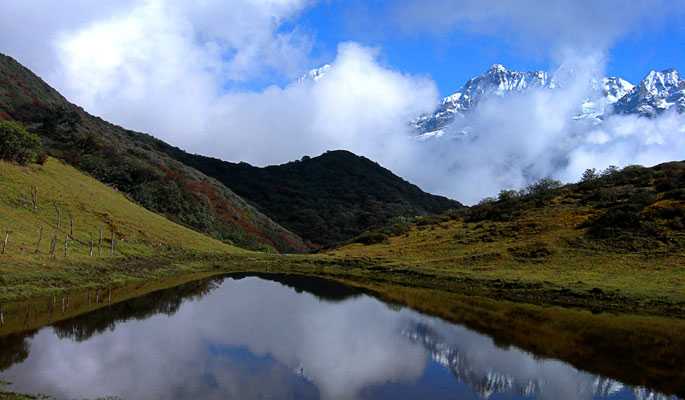
Kanchenjunga National Park
Hills Valleys, Rivers Lakes, Trekking,
About Kanchenjunga National Park
Far From City: 32 kms from city center
Cost:
About Kanchenjunga National Park
Weather:
Time Required:11 days
Flora and Fauna at Kanchenjunga National Park
Steeped with exquisite beauty all around, Kanchenjunga National Park is home to endangered species like Oaks, Birch, Willow, and Maple along with several rare medicinal plants. You will also spot Alpine grasses, shrubs inhabiting the region in this temperate and humid biome. Also about more than 550 species of birds alone inhabits this region including green pigeon, tragopan pheasant, blood pheasant, Tibetan snowcock, and Himalayan Griffon. A new species of bird named Himalayan Forst Thrush was discovered in 2016. It also houses several varieties of reptiles, mammals, and insects like Himalayan Tahr, Himalayan Blue Sheep, wild dog, snow leopard, red panda, Tibetan wild ass, and sloth bear, etc.
Kanchenjunga National Park Trek
There are a number of popular trekking options you may undertake here. Permits for all the treks are obtained from Wildlife Education and Interpretation Center at Yuksum which is the starting point of most of these treks. The state government also organizes treks along with private agents. Some of the famous trekking routes are:
Yuksom - Tshoka - Dzongri
Bakim - Dzongri - Thangshing - Samuteng - Goechala
Dzongri Base Camp - Rathong - Khangerteng
Thangshing - Lam Pokhari - Kasturi
Orar - Labdang - Tashiding.
Lucanes Jakchen-Yabuk-Rest Camp (Marco Polo Camp) - Green Lake
Lachen-Thasngu (4,174 m) - Muguthang (4,900 m) - Thay La (5,200 m) - Khyoksa La (5,500 m) - Rest Camp - Green Lake.
A permission of the State Cheif Wildlife Warden is also a must before visiting the national park. Almost all the treks pass through the Kanchenjunga National Park.
Kanchenjunga National Park Permit & Fees
The entry to the Kanchenjunga National Park is restricted and regulated. An inner-line permit needs to be obtained by the Indian Nationals and an inner-line permit by the foreign Nationals, issued by the Ministry of Home Affairs. A permit also needs to be taken from the Chief Wildlife Warden, Government of Sikkim in accordance with the Wildlife (Protection) Act, 1972. He grants permission to visit the National Park for the purpose of tourism, photography, scientific research and studying wildlife for a fee.
The following permit fees are applicable :
Indian Nationals:INR 300 per head for the first seven days. INR 40 for additional days.
Foreign Nationals:INR 560 per head for the first seven days. INR 80 for additional days.
Students:INR 80 per head for the first seven days. INR 20 for additional days.
Tent charges:INR 50 per day
Guide Charges:INR 10 per day
Photography Charges:Still Camera: INR 30 Video Camera: INR 1000 Movie Camera: INR 35000
History of Kanchenjunga National Park
The Kanchenjunga National Park gets its name from the third highest mountain in the world - Kanchenjunga. The word Kanchenjunga literally means 'Abode Of God'. The national park is juxtaposed against this massive mountain, which acts as a striking background at an imposing height of 8586 meters. This area was declared as a National Park in 1977. Initially, the area of the National Park was 850 km sq which was extended to 1784 km sq.
Surprisingly, Kanchenjunga National Park also holds religious significance. In Buddhism, Sikkim is presented as a sacred land and according to some scriptures, the area of the park is originally the sanctum sanctorum where the Buddhist masters had hidden the religious treaties and texts to be later discovered by the people. According to the officials, these hidden treasures are called "ters", destined to be discovered by "ter-tons" which literally means treasure revealers. This has ensured that the sacred places littered the park are not defiled, helping in sustained preservation.
Best time to visit Kanchenjunga National Park
The best to visit the Kanchenjunga National Park is from March to May and September to Mid-December. It receives snowfall for the most part of the year. The treks are also organised by the forest and state department in accordance with the prevailing weather conditions.
How to Reach Kanchenjunga National Park
Bagdogra, 222 kilometres away is the nearest airport with connectivity to Kolkata, Delhi, and Guwahati. A helicopter service also runs from Bagdogra to Gangtok.Jalpaiguri, 221 kilometres away is the nearest railway station. The national park is well connected from Jalpaiguri via roads and you may book a taxi.The park is also well connected to major cities and is accessible through roads through NH-31A via Gangtok-Sevlok Road. You'll find state and private buses to the national park at regular intervals.
Top Tourist Places in West Sikkim
Geyzing
Pemayangtse Monastery
Darap village
Yuksom
Rabdentse Ruins
Legship
All Tourist Places in West Sikkim
Where to Stay
Range office at the National Park provides accommodation options with four houses containing twenty beds. Many people also prefer to stay in Gangtok which has plenty of accommodation options and travel to the Kanchenjunga National Park for a day trip.
Tips
1. Make sure you obtain all the required permissions and permits to trek in the region which is a must.2. Avoid the use of firewood or kindling any kind of fire in the forest areas.3. You are not allowed to play loud music or use loudspeakers.4. Do not swim in the lakes and rivers located inside the national park and protected areas.
Photos of Kanchenjunga National Park
Comments on Kanchenjunga National Park
Post Your Comment




















